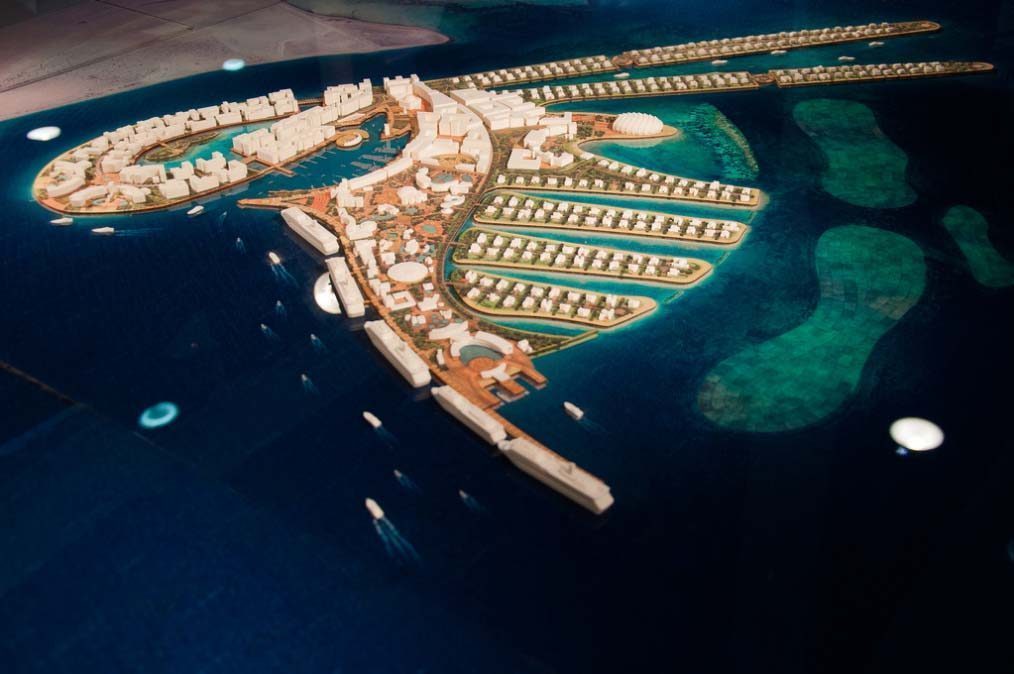
One of the country’s largest real estate developers has quietly shelved plans for a $5.5 billion (QR20bn) artificial island resort off of Doha’s coast, according to its top executive.
Last year, Barwa Real Estate unveiled its proposal to construct Oryx Island, a 445-acre land mass featuring luxury villas with private beaches and a water park. It was also intended to accommodate several cruise ships that could be turned into “floating hotels” to accommodate some 25,000 football fans during the 2022 World Cup.
When asked by Doha News about the status of Oryx Island, Ahmed Al Abdulla – Barwa’s acting CEO – said his company’s vision had been to make use of the material generated from constructing the Doha Metro:
“We expected more than 40 million cubic metres of excavation material (to be created from constructing the rail project). We proposed (Oryx Island) to solve and handle those excavation materials, half of which were to create this island, but it did not go through,” he said at the annual Cityscape Qatar real estate show – the same venue the company used to announce the project last year.
While some are bound to be disappointed by the decision to shelve plans for Oryx Island, local residents will soon have a wealth of other new hospitality options, as more than 100 hotels and serviced apartment blocks are currently under construction.
On the high-end front, there are also plenty of these types of residential properties available in Qatar, including thousands of completed units at the Pearl-Qatar and new properties at Lusail, a 38 sq km manmade city located on the coast of Qatar.
Fox Hills
Barwa launched sales of its first 231 units in the Fox Hills district of Lusail on Monday and sold out within 24 hours, Abdulla said, adding some 100 would-be buyers have asked to be put on a waiting list.
When asked why homeowners would purchase off-plan in Lusail over completed units in the Pearl-Qatar, Abdulla conceded he was a bit taken aback by the interest among buyers:
“I’m surprised,” he said in an interview. “The Pearl is ready. Some of (their) prices are less than our price. But people trust in us and are buying.”
Barwa’s development in Lusail, dubbed “Dara,” will ultimately include 53 buildings containing some 1,000 residential units. Abdulla described it as a mixed-use community with hotels, coffee shops, spas, health clubs and other amenities.
“You will be able to walk between the buildings. If you see Fox Hills, many of the (other proposed) buildings are (owned by) individual investors. They will build it, fence it and that is it. But here, we are creating (a community),” he said.
Construction will start this year and is slated to wrap up in the first quarter of 2017.
While different portions of the Lusail City project have fallen behind schedule, Abdulla didn’t offer any comments on previous timeline targets. When asked why Barwa is only starting to build now, he smiled and said, “Now is the right time.”
Workers’ city
Meanwhile, Barwa officials said they expect the first residents of a massive new “Worker’s City” residential development in the Industrial Area to move in July 1.
Eight of the first 23 Barwa al Baraha buildings have already been leased to companies employing laborers, with the balance expected to be taken by September, Abdulla said. Some 20,000 workers are expected to be living in Barwa al Baraha – which also contains four dining halls, two mosques and other amenities – by the fall.

Another 20,000 residents will be housed in the next phase, which is currently under construction and is expected to be completed within 18 months. A final phase will contain a medical clinic and accommodate senior staff in single-bedroom units.
A truck parking lot, billed as the world’s largest, opened on the site in January.
The 1.8 million sqm development was originally expected to be completed in mid-2010, a year before Qatar implemented a ban on single men working with contracting and construction companies from living in residential areas.
In arguing that Qatar is committed to improving conditions for the country’s labor workforce, the country’s labor minister made a publicized visit in February to the Worker’s City, which was called a “tribute” to the country’s expat population when it was launched.
A Barwa official confirmed that a typical bedroom on the site is designed for six people and furnished with three bunk beds. That would appear to exclude it from accommodating workers directly involved with World Cup or Qatar Foundation projects.
Earlier this year, the country’s tournament organizing committee released standards for workers’ living and working conditions that including a ban on bunk beds and a maximum of four people assigned to a room, mirroring QF requirements.
When asked about the accommodations, a Barwa official at the company’s Cityscape booth said, “Whatever the government standards are, we’ll abide by it.”
Thoughts?







